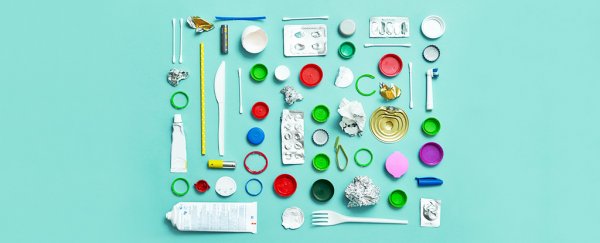Our planet and everything that lives on it is buckling under the weight of all the plastic waste we're producing. The volume of these non-biodegradable materials discarded after use is only increasing, so we need new ways to tackle them, and fast
A new study demonstrates the proof-of-concept of an entirely new approach to plastic recycling, inspired by the way nature naturally 'recycles' the components of organic polymers present in our environment.
The approach takes guidance from the fact that proteins within organic polymers are constantly broken down into parts and reassembled into different proteins, without losing the quality of the building blocks. In essence, when it comes to recycling plastic – a synthetic polymer – without degrading it, we have to think smaller.
Proteins are one of the main organic compounds that act as building blocks for everything biological. They're long chains of molecules (or monomers) known as amino acids, and researchers think that the way these molecules can be broken up and reconfigured suggests a potential strategy for recycling synthetic polymers.
"A protein is like a string of pearls, where each pearl is an amino acid," says materials scientist Simone Giaveri, from the École polytechnique fédérale de Lausanne (EPFL) in Switzerland.
"Each pearl has a different color, and the color sequence determines the string structure and consequently its properties. In nature, protein chains break up into the constituent amino acids, and cells put such amino acids back together to form new proteins – that is, they create new strings of pearls with a different color sequence."
The researchers have called their approach "nature-inspired circular-economy recycling", or NaCRe for short.
In lab tests, the team was able to divide selected proteins into amino acids, then assemble them into new proteins with different structures and uses. In one case, they turned the proteins from silk into green fluorescent protein, which is a glowing tracer used in biomedical research. Despite this deconstruction and reconstruction, the quality of the proteins remains constant.
 (Giaveri et al., Advanced Materials, 2021)
(Giaveri et al., Advanced Materials, 2021)
According to the team's analysis, the mechanisms that naturally occur in proteins could be applied to plastics as well, though developing and scaling up the necessary technology is going to take some time.
There are major differences between natural and synthetic polymers to be taken into account, but the researchers say this new approach to recycling is feasible – and would keep materials in use for the longest possible time.
"It will require a radically different mindset," says materials scientist Francesco Stellacci, from EPFL. "Polymers are strings of pearls, but synthetic polymers are made mostly of pearls all of the same color and when the color is different, the sequence of color rarely matters."
"Furthermore, we have no efficient way to assemble synthetic polymers from different color pearls in a way that controls their sequence."
Even biodegradable plastics create waste residue that must be stockpiled or buried after the recycling process is finished, with the usual knock-on effects for the environment in terms of land usage and pollution. The new strategy could help fix that.
The researchers estimate that across a 70-year lifespan, a person throws away around 2 metric tons of plastic on average – and considering almost 8 billion people are on the planet right now, that's a catastrophic amount of waste.
And while we're making some progress in tackling our plastic pollution problem, it's currently nowhere near enough. A radical shift in thinking and action is required if we're going to stop plastics doing further damage to our world and our health.
"In the future, sustainability will entail pushing upcycling to the extreme, throwing a lot of different objects together and recycling the mixture to produce every day a different new material," says Stellacci. "Nature already does this."
The research has been published in Advanced Materials.

No comments:
Post a Comment